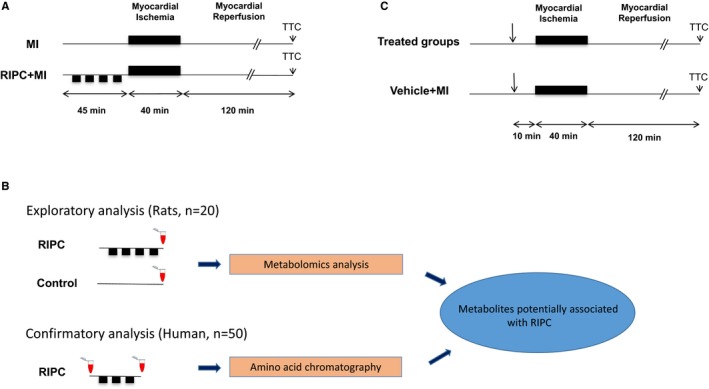Figure 1.

Experimental protocol. A, Cardioprotective effects of remote ischemic preconditioning (RIPC). In the myocardial infarction (MI) group, rats were subjected to 40 minutes of coronary occlusion followed by 120 minutes of reperfusion (n=8). In the RIPC+MI group (n=8), rats were subjected to RIPC achieved by a vascular clamp placed on the upper right femoral artery in order to induce 4 cycles of 5‐minute limb ischemia, interspersed with 5‐minute limb reperfusion before MI. Infarct size was assessed using 2,3,5‐triphenyltetrazolium chloride (TTC) staining. B, Schematic overview of experimental protocols applied for metabolomic analysis. In the exploratory stage, 20 rats were subjected to RIPC or a control procedure (exposure of upper right femoral artery without clamping). Blood was sampled immediately after the RIPC procedure in the RIPC group or 40 minutes after exposure of the femoral artery in the Control group. A targeted metabolomics analysis was conducted in order to find which metabolites potentially participate in the protection conferred by RIPC. In the confirmatory analysis, a set of 50 patients were subjected to RIPC achieved by 3 cycles of 5‐minute inflation to 200 mm Hg and 5‐minute deflation of an automated upper‐arm cuff inflator. Blood was sampled before and after RIPC. Based on the results of the exploratory analysis, amino acid chromatography was conducted on these samples in order to confirm changes of these metabolites in humans. C, Administration of potentially cardioprotective metabolites found in (B). MI was induced in rats as described in (A). In the treated groups (n=39), metabolites alone or in combination were injected intraperitoneally 10 minutes before coronary occlusion. In the Vehicle+MI group, rats received vehicle only intraperitoneally (n=12).
